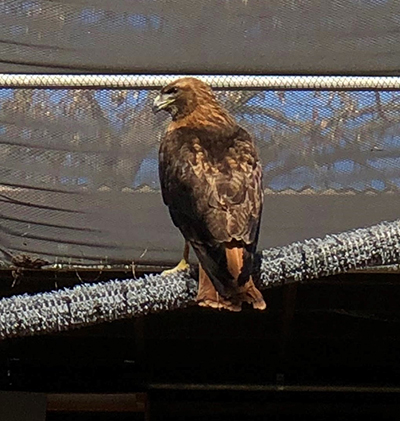Fixing a Fierce Fighter’s Feet
A few months ago, Red-tailed Hawk 21-233 arrived at the California Wildlife Center from Malibu with very little history. All the techs in ICU knew at first was that he was injured. What they found on examination was a bird with some wounds on his chest, some broken feathers and, much more concerningly, feet that were in terrible condition. There were multiple deep, painful lesions on the bottoms of the feet, skin and scales dark with infection and necrosis extending out onto the digits towards the talons. Lab tests showed elevated white blood cells, indicating a significant immune response; plus there were parasites living in his GI tract, stealing nutrition from whatever food he was given and damaging the intestinal lining.
Hawks live by the health of their feet. It’s the talons that catch their prey and help protect them against enemies. If a hawk’s feet are too damaged or infected, they can’t survive. What caused 233’s injuries can’t be known for certain, but it’s suspected they may have occurred in a fight with another hawk. During conflict, they may wrestle with each other, grabbing each other’s feet and chests. This would explain the deep cuts and gouges, because hawk talons are sharp and very, very strong. The wounds, whatever caused them, then became infected and the parasites, responding to a weakened immune system, could then proliferate.
Initial critical care treatments were started. By early the next day, 233 was depressed and unable to stand, which is when I first saw him. After examining the bird, despite his then poor condition, I felt he had a reasonable chance to recover and be returned to the wild, so I reviewed and expanded his treatment plan. This would evolve over time, including soaking the feet periodically in a particular veterinary disinfectant (cleaning away a lot of the black, crusty, infected, and dead tissue), foot dressings, antibiotics that were both systemic and could penetrate deep tissues not well supplied by the circulatory system, and medication for pain and inflammation. He was also treated for his GI parasite freeloaders. Patients like this are given nutrition in both liquid and solid form until they’re back to self-feeding.

Red-tailed Hawk during physical therapy,
Photo by Dr. Guthrum Purdin
After several weeks, once the worst of the injuries were resolved, we switched to a once-every-three-days medication to reduce handling. Thus, reducing stress for 233…and for his handlers! Finally, it was aviary time for this tough bird. Flight at first was weak, only getting about 3 feet off the ground on his initial attempt.
Allowed to rest quietly in his new, bigger flight space, after a few days, staff and volunteers would go into the aviary daily to encourage 233 to do his physical therapy, flying from one end of the aviary to the other. This was easy for 233, since wherever people were, he did not want to be. Hawk 233 was wild to the core! Gradually, he flew better and better. A companion, a juvenile Red-tail, was introduced to aviary (they were closely monitored to make sure they got along and would not fight). During PT sessions, 233 easily out flew the youngster.
Then the great day came. On recheck exam, after weeks off meds, his original injuries were all definitely healed and in the past. I spent some time observing 233 in the largest aviary and found he could fly with the best. Just a few days after that, after about 2½ months in care, this memorable hawk was released back into the Malibu sky. What an amazing patient!

Thank you for sharing this wonderful story!!
Thank you for all that all of you do to help and saving our wildlife!!!!
So inspiring. Your story encourages us to try and save every life. This hawk seemed impossible at first description, but you didn’t give up. Much appreciation for everyone’s work at CWC!
I love all your stories but this one is so memorable! I love the fighting spirit of this majestic Hawk and hope he lives a long and healthy life thanks to the California Wildlife Center!
Love hearing about the patients at CWC, no different with 233. Thank you for all the work you do, and sharing the stories with us!
So great that this amazing bird healed through CWC’s care. Keep up the good work!!
Thank you so much for sharing this wonderful story. I found it informative and happy for this patient’s outcome. You do such marvelous work!